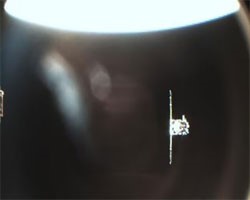SSC Current Affairs
TABLE OF CONTENTS |
| Science and Technology |
|---|
|
|
|
Why in the News?
The Indian Space Research Organisation (ISRO) has successfully completed the docking process of its SpaDeX satellites, marking a significant milestone in space technology. With this achievement, India has become the fourth country to demonstrate docking capability after the US, Russia, and China. The successful docking process was announced on January 12, 2025, with potential applications for upcoming missions like Chandrayaan-4 and the planned Bharatiya Antariksh Station. Key Takeaways: SpaDeX Mission Details: The SpaDeX (Space Docking Experiment) mission involved two small satellites, SDX01 (Chaser) and SDX02 (Target), launched on December 30, 2024. After maintaining an initial separation of 20 km, the satellites gradually reduced the distance to 3 meters before completing the docking process. Docking Process: The docking involved complex maneuvers, including positioning the satellites at specific intervals (15 m and 3 m) and achieving a successful rigidization for stability. The docking process demonstrated the capability for electrical power transfer between the satellites. Chandrayaan-4 Mission: Chandrayaan-4, planned to return lunar samples to Earth, will be India’s first mission requiring docking capability. The mission involves multiple docking and undocking exercises in Earth and lunar orbits. Space Station Plans: The docking capability is also critical for India’s proposed space station, the Bharatiya Antariksh Station, whose first module is expected to launch in 2028. Historical Achievement: This milestone places India among the elite group of nations capable of spacecraft docking, showcasing advanced space technology. Additional Context: ISRO’s Challenges and Milestones: The SpaDeX docking schedules faced technical challenges, leading to postponements from January 7 to January 9 before achieving success on January 12. ISRO announced the docking process post-success, highlighting its precision and innovation in overcoming challenges. Applications of Docking Capability: Future human space missions, including India’s lunar mission, planned before 2040, will rely on this technology. The capability will also support India’s ambitions for modular space station development. Details of the SpaDeX Mission: After launch, the satellites were positioned to gradually reduce separation, demonstrating incremental advancements in space docking. The experiment will further the operation of respective payloads for up to two years. Significance of Chandrayaan-4: Chandrayaan-4 aims to return lunar samples to Earth through intricate docking and transfer modules, a capability demonstrated by the SpaDeX mission. Implications for India’s Space Ambitions: With the SpaDeX success, ISRO has bolstered its ability to execute complex space missions. This achievement is a stepping stone towards advanced space exploration, solidifying India's position as a major player in global space technology. |
|
|
|
Key Points about ISRO (Indian Space Research Organisation)
Headquarters: Located in Bengaluru, Karnataka, India. Current Chairman: Dr. V. Narayanan (11th Chairman) (as of 2025). Founding Year: Established in 1969 by Dr. Vikram Sarabhai, known as the father of the Indian space program. Parent Organization: Operates under the Department of Space (DoS), which comes under the direct oversight of the Prime Minister of India. Vision and Mission: To harness space technology for national development while pursuing space science research and planetary exploration. Key Launch Site: Satish Dhawan Space Centre (SDSC), Sriharikota, Andhra Pradesh. Notable Achievements: Chandrayaan Missions: Successful lunar exploration missions, including Chandrayaan-3's historic landing on the Moon. Mangalyaan: Mars Orbiter Mission, India's first interplanetary mission. Gaganyaan: India’s upcoming human spaceflight program. SpaDeX Docking: Successfully demonstrated docking technology in 2025. Major Rockets: PSLV (Polar Satellite Launch Vehicle): Known as the "workhorse" of ISRO. GSLV (Geosynchronous Satellite Launch Vehicle): For launching heavier payloads. LVM-3 (Launch Vehicle Mark-3): Used for Chandrayaan-2 and future crewed missions. Significance: ISRO has positioned India as a global leader in affordable space technology and commercial satellite launches through its Antrix Corporation and NewSpace India Limited (NSIL). Motto: “Space Technology in the Service of Humankind.” |
|
|
|
Why in the News?
India achieved a record 30 GW of renewable energy capacity addition in 2024, marking a 113% increase from 2023. This milestone highlights India's accelerating shift toward clean energy, as part of its commitment to achieve 500 GW of renewable energy capacity by 2030. Key Takeaways Record-Breaking Growth 30 GW renewable energy capacity added in 2024, compared to 13.75 GW in 2023. India’s total cumulative renewable energy capacity is now nearly 218 GW. 500 GW Target by 2030 India aims to add 50 GW per year on average to meet the 500 GW renewable energy target by 2030. This initiative is part of India’s global climate commitments to reduce carbon emissions. Government Policies and Efforts India’s renewable energy capacity has grown steadily since 2014, when it was 35.84 GW. The previous record was 18.48 GW capacity addition in FY2023-24. Key Collaboration Organizations like BHEL (Bharat Heavy Electricals Limited) and ONGC (Oil and Natural Gas Corporation) are working together to accelerate India’s green energy transition. Minister’s Statement Pralhad Joshi, Minister of New & Renewable Energy, emphasized the exponential growth in renewable energy and reaffirmed India’s commitment to a greener future. Significance India’s record-breaking green energy milestone showcases its leadership in the global shift to sustainable energy and its focus on building a carbon-neutral economy. |
|
<< 12-Jan-25
|
|
|

